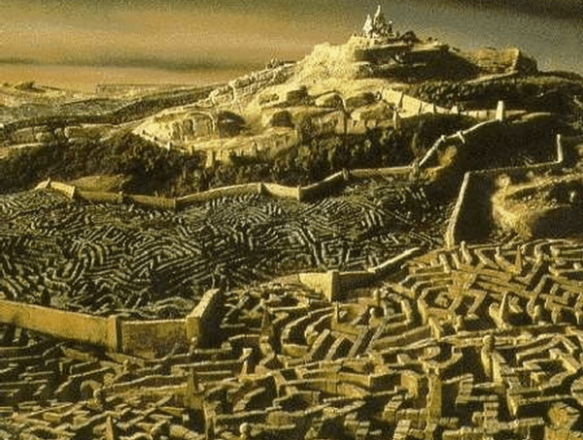Taken from:
thelastsyllableblog.wordpress.com
Featured on The State Of The Arts magazine:
http://www.thestateofthearts.co.uk/features/36110/
“I have always imagined that Paradise will be some kind of library” – J.L.B.
–
Jorge Luis Borges was perhaps the finest and most puissant artificer of literary puzzles the 20th century saw. In the past I have spent much time lauding similar qualities in his American contemporary and purveyor of transcendent sci-fi Philip K Dick, an equally skilful creator and destroyer of convoluted fictional worlds, yet not once have I mentioned this titan of Latin American literature. Well, it is time to address that.
I came across the Argentine’s work in my final year of University, in the middle of a module that focussed on Narrative, specifically what interesting things could be done with such an intangible yet integral literary concept. A few of Borges’ short stories absolutely blew me away and, like Philip K Dick, he is an accomplished grand-master of the twist ending. However, where Phil Dick needs 200 pages to first create then spectacularly invert and destroy his reader’s world, Borges needs only 2.
–
Born in Buenos Aires in 1899, Jorge Luis Borges became a prolific and successful short-story writer and poet, as well as an esteemed translator and essayist. Blending a deeply philosophical literary style with plot elements that belong firmly in the realm of fantasy, it is fair to say that Borges blazed the trail for various writers of the Latin-American tradition of magical-realism such as Gabriel Garcia Marquez and directors of film including Claudia Llosa and Patricio Guzman. Borges’ stories revolve around recurring motifs such as labyrinths and libraries, with one particularly memorable story being set in an infinite hexagonal library filled with every book that ever was or will be written*; indeed Borges’ prose borrows much from the dream-world.

It was doubly fascinating studying Borges alongside another module which covered Representations of Trauma in Latin America. Indeed many South American authors and directors of various nationalities found in their work an escape from the horrors imposed upon them by various oppressive US-backed regimes; thus Magical Realism was a reaction against both the terrible situations found on a turbulent Latin-American continent and against the prevalent realism and naturalism of 19th century literature.
Seeing as I am due to embark upon my own South American Odyssey, it seems prudent that before I lose myself in the sublime wilds of Patagonia and vast jungles of the Pantanal, we had better lose ourselves in Borges…

THE HOUSE OF ASTERION
One of Borges’ shortest short stories yet also one of his most devastating both in terms of his stylistic prowess and the effect his revelatory twist endings, ‘the house of Asterion’ begins as many of Borges’ stories do, with some bibliographic detail that firmly anchors the story within the realms of historical reality: prefaced in this case with a quote from a presumably ancient historian; “and the queen gave birth to a child, who was named Asterion – Appollodrus Bibliotecha III, I”. The story is then told from the point of view of the eponymous Asterion, whose erudite and graceful language seemingly betrays his noble birth in the minds of the reader.
Asterion then proceeds to tell us about life from his point of view. He lives a lonely existence, presumably kept in isolation from commoners due to his royal lineage, declaring “not for nothing was my mother a queen.” He occasionally performs a ceremonial ritual that is expected of him, freeing commoners from their curses or “freeing them from evil”, but aside from that spends his days running and charging through the cavernous halls of his house alone, pretending to be various animals.
Asterion’s house has 14 identical doorways and hallways, Borges the editor here annotating 14 as probably the highest number Asterion has ever needed to count to and therefore being analogous for infinity. Asterion observes that his house is “as big as the world, or rather it is the world.”
Borges even gives Asterion is own theology; having spent his entire life in near-isolation Asterion has the very human urge to make sense of his world, musing “Perhaps I have created the stars and the sun and this enormous house. Perhaps I no longer remember.”
All of these small, human details serve to wrong-foot his reader. And it is with spectacular effect, in a moment of vertigo-inducing inversion, that Borges pulls the carpet out from underneath his readers…
“The morning sun reflected from the bronze sword. There was no longer any vestige of blood. ‘Would you believe it Ariadne?’ said Theseus, ‘The minotaur scarcely defended itself!’”

The Minotaur 1885 George Frederic Watts 1817-1904 Presented by the artist 1897 http://www.tate.org.uk/art/work/N01634
Borges revelation that Asterion is in fact the Cretan Minotaur from ancient Greek myth is made all the more sensational by Borges’ skill as a writer, whose clever attention to detail shows us a completely human side to a creature otherwise regarded as in-human. The small things such as Asterion’s theology, his loneliness, the games he plays, his descriptions of his ‘house’, all wrong-foot the reader, resulting in the following two things: An intensification of Borges’ stomach-churning twist ending and also the realisation that over the course just two pages, Borges has forced us to unknowingly reconsider the universe from the point of view of a creature we would normally consider completely different to ourselves. A worthy achievement for a writer working through a century of unprecedented racial and ideological conflict.

It is with a heavy heart then, that with the passing of one famous denizen of a Labyrinth, I get the opportunity to introduce the architect of another. ‘The House of Asterion’ is but one scintillating example of Jorge Luis Borges’ evocative work. Scattered throughout his collections of fiction are others, as multitudinous as the books in his infinite library of Babylon and every bit as worthy of discovery.
(Words taken from my feature done for The State of The Arts magazine, January 2016)
RECOMMENDED SHORT STORIES & WORKS:
THE GARDEN OF FORKING PATHS
*THE LIBRARY OF BABEL.
THE CIRCULAR RUINS
“The Aleph”
“Ficciones”
“Labyrinths”












